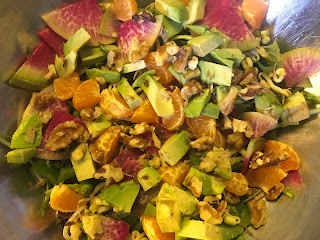Warning: This post contains pictures of dead chickens (no blood though!). Proceed at your own risk.
One of my many jobs includes rooster removal service. If you have a rooster or three that are getting on your nerves, or in Rick's recent case, causing you bodily harm, then you can call me up and I will "deal" with your problem. Roosters, a source of free meat along with old laying flocks, have a welcome place in my freezer and eventually, crockpot. I have yet to meet an old rooster or hen that my slow cooker can't cook up into a delicious stew.
 |
A friend's roosters, troublesome no more.
|
|
I generally like to keep a rooster around, as they really do function well to protect their hens. And I occasionally let my broody Muscovy ducks sit on chicken eggs to hatch out and raise new chickens for me. Saves me a lot of work and mess! But in the spring, even nice roosters get nasty and will become aggressive. Rick was walking by our rooster, 20' away and nowhere near the hens, when the rooster attacked him, puncturing his calf with its spur.
 |
| Check out the size of those spurs! |
Or maybe it wasn't that it is spring and hormones are flying, it could be continued bad rooster Mojo. Once upon a time, I had a really sweet rooster who never attacked anyone. The Muscovy Mothers sat on the presumed fertilized eggs, but nothing would happen. Assuming the cock to be a dud, I traded him for a neighbor's rooster, Loki, on the day when she was processing her meat birds. I should have known that accepting a rooster named Loki (Norse god of trickery) was bad luck and indeed, as I was throwing the rest of the eggs away in the compost, assuming them all to be rotten, I saw that some were not and in fact, had growing chicks in them. I quick called up my neighbor, but it was too late. We were stuck with Loki (not for long though!) and have had bad rooster luck ever since.
And now we have 27 new roosters! Why all males if they're such trouble, you ask? Because males grow bigger, faster, and these birds are being raised specifically for meat. They are known as
Red Rangers and will be raised for about twelve weeks, just shy of when they start to turn on each other, and us! Here they are, cute as can be at a week old.
 |
| 27 Red Rangers + 1 unknown (chickery always sends a "mystery" bird) |
My philosophy on keeping animals and eating meat is that if possible, use everything! I won't go into the details (but if you're curious,
check this out!), but in the raising of my chickens for meat, everything eventually has a use. The feet are a healthy and delicious addition to soups and stews, adding important glucosamine (about 450 mg./foot!) and collagen to the broth for a silky smooth texture. Not a huge fan of organ meats myself, they get fed to the dogs, either directly or made into dog treats. The feathers go into the compost. The bedding from the chicken house is an important fertilizer in my garden. The carcass from roasted chicken gets made into soup. I recently tried cooking the bones for several days to soften and make into dog food, but it turns out that the older the bird, the less likely the bones will ever soften, so I may need to get a grinder because even two days in a crock pot did nothing to soften these bones!
I know that not everyone has the desire and/or ability to go through such measures for their meat-eating habits. If there is something positive to come out of this pandemic, my hope is that it will be an awareness and drive to change the way our country raises animals for consumption. I think it's pretty clear that our mono-culture way of producing chicken nuggets, pork chops, and burgers is not only a bad deal for the animals and the environment, but for humans as well, the workers who work in these mega-plants and now the entire population who are having to forgo their Wendy's burger because of the meat monopoly. The only ones to benefit from this system are the few on the top who own these corporations.
I know not everyone can afford meat from uber-happy raised animals. Somewhere though, there needs to be a balance between the $0.99/lb pork shoulder sold by your local grocery store and the $9.99/lb sausage from free-range heritage pigs sold by my local pig farmer. A good
article from the Guardian describes the many factors on this issue and mentions the
Berkeley Food Institute. This organization is new to me and already, I love their mission statement because it is all-compassing, that this is not just an animal rights issue, but a human rights issue, from the farmer to the worker to the eater - "The Berkeley Food Institute strives to transform food systems to expand access to healthy, affordable food and promote sustainable and equitable food production. We empower new leaders with the capacity to cultivate diverse, just, resilient, and healthy food systems."
Disclaimer: I wish I could say that no animals were harmed in the production of this post, but, I can't. I can say though that the animals lived a good life and met a swift end, that their lives will be appreciated in many ways, from the hens they protected, to the human bodies they will sustain, to the jewelry that my friend's daughter is making out of the beautiful rooster feathers! And I still have one rooster left - my punk rocker!

















